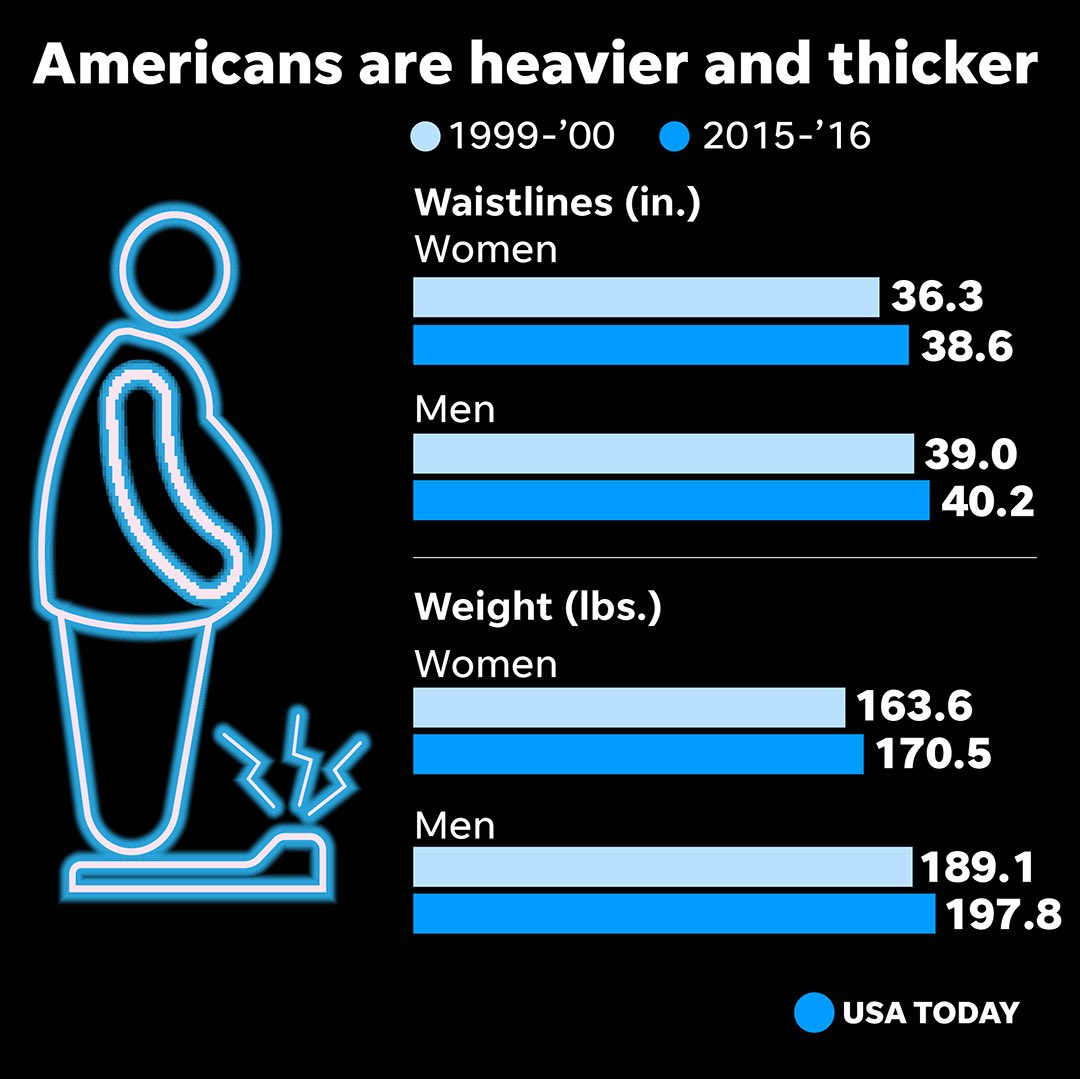
Americans are getting Fatter
Just
in time for Xmas cookies, Feds remind our waists and weight are
increasing. And women expanded twice what men did around the middle.
Belly fat is of particular concern when it comes to women and heart
disease.
If you think Americans are getting fatter, the feds say: 'You're right, all of us are'
Americans
have gotten heavier and thicker in the 21st century, with the numbers
on the scale going up for men and women of all ages, according to a new
federal report released Thursday.
Waistlines have
ballooned, too, the National Center for Health Statistics said. In
general, women’s waists grew more than 2 inches, from 36.3 in 1999-2000
to 38.6 inches in 2015-16. By comparison, men's middles increased just
over an inch, from 39.0 to 40.2 inches during the same period.
The new report offers hard data for a phenomenon plainly visible on city streets, schoolyards
and workplaces: In the past 30 years, obesity has risen to epidemic
levels in the United States, but the nation still hasn’t been able to
correct the problem. Being overweight can contribute to a cascade of
other health problems, including diabetes, heart disease and cancer.
Dana
Duffie of Orlando learned that first hand. She had been comforting
herself with food since she was little and then wound up with Type II
diabetes after her daughter developed cancer in the 1990s. After her
daughter died at 16 in 2002, stress eating became an even bigger
problem. She hopes talking about it will encourage her to address it.
"My
father was an alcoholic, and as an adult I had a light-bulb moment when
I realized I had learned some unhealthy things from watching him: I was
hiding empty family-size candy bags or empty Little Debbie boxes or
even the wrapper of that second sub that was supposed to be tomorrow's
lunch, all went underneath the other trash in the kitchen trash can
after everyone else went to bed.," says Duffie "It's what got me where I
am today, which is insulin dependent."
The report
was based on data gathered through the National Health and Nutrition
Examination Survey, which looked at weight, height, waist circumference
and body-mass index in about 45,000 Americans 20 and older.
“It’s
what your grandma would have told you, and hearing it from a professor
now is no less important,” said Dr. Shailendra Patel, chairman of the
division of endocrinology, diabetes and metabolism at the University of
Cincinnati College of Medicine. “You need a varied diet, a balanced diet,
with smaller portions. Your plate should look colorful, and you need to
be exercising at least three times a week.”
Christine
Rufkahr of St. Louis is just trying to do her own version of that, in a
transition she describes as going from a "junk food vegan diet to a whole food plant-based diet."
This diet has no meat, eggs or dairy but also eliminates most processed
foods, added sugars or sweeteners and fats including olive oil.
Rufkahr
believes many, like herself, "self medicate" for her mental health
which wouldn't happen "if people had access to effective treatment."
The waistline news is particularly grim for women.
A March study in the Journal of the American Heart Association, the women who carried more weight around their middles had a 10% to 20% greater risk of heart attack than
women who were just heavier over all. This weight was measured by waist
circumference, waist-to-hip ratio, or waist-to-height ratio. The study
involved about 500,000 people (55% of them women), aged 40 to 69, in the
United Kingdom. The researchers took body measurements of the
participants and then kept track of who had heart attacks over the next
seven years.
The
analysis showed that compared with body mass index (BMI) - a
calculation of weight in relation to height - a waist-to-hip ratio was
18 percent stronger as a heart attack predictor in women compared to 6
percent stronger in men.
Roland
Whitsell, a former business school professor in Gallatin, Tenn., says
excess weight crept up on him over the years as he would gain when he
was experiencing depression but wouldn't lose it when he wasn't
depressed. He says he's 5'10" and weighed 233 pounds when he retired 10
years ago at age 70. He says he has finally lost 20 pounds by increasing
both his protein intake and his exercise, especially through
backpacking, which he took up a couple years after his retirement.
He's even still hoping to hike the Pacific Crest Trail in 2021. His last attempt got cut short.
"I
learn something each time that makes me better at backpacking," he
says. "I am getting in better shape and working to have a lighter base
weight."
Whitsell has also lost at least a half
inch since he got out of the Army in 1956. That's in line with what
middle-aged men lost in height since 1999.
Dr.
Malti Vij of the University of Cincinnati Health Weight Loss Center in
West Chester, Ohio said studies such as Thursday’s present the overall
bad news about the nation’s weight problem. But “these kinds of surveys
are helpful at least when they are dividing by race and by age group and
gender. They tell us where to focus our efforts. Looking at the data,
it looks like we have to focus everywhere.”

No comments:
Post a Comment